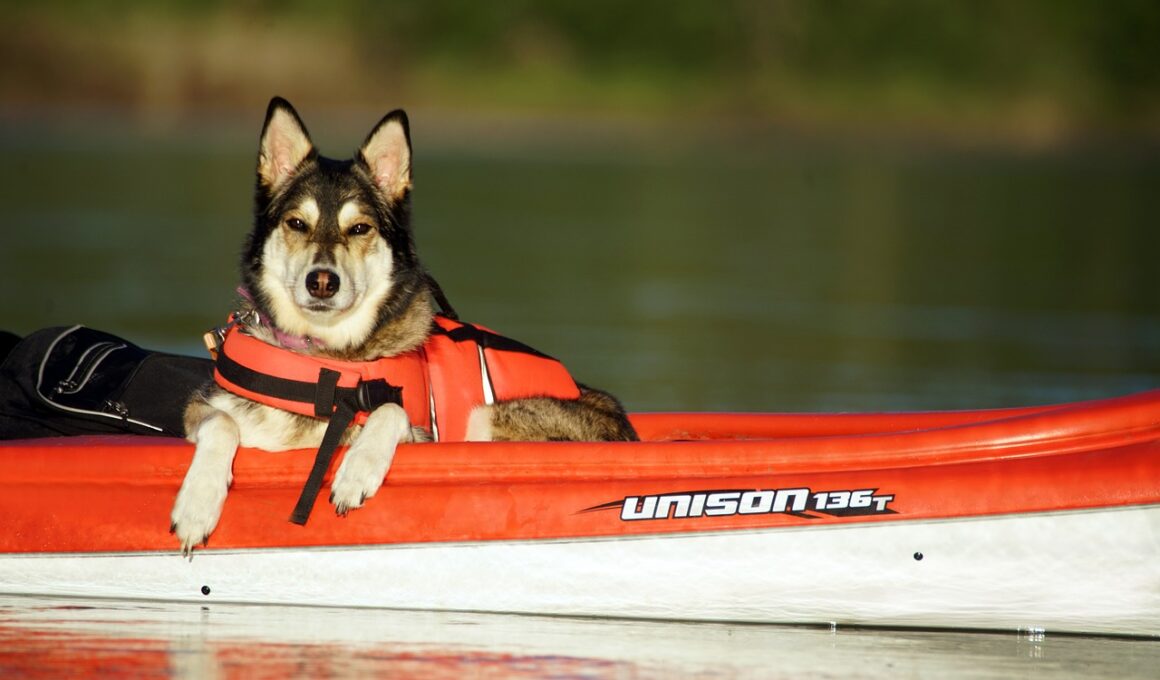How to Safely Travel with Dogs on Boats and Watercraft
Traveling with your dog on boats and watercraft can be a fun adventure, but it’s essential to prioritize safety. Before embarking on your journey, ensure your dog is comfortable with water and being on a vessel. Start with short boat rides to acclimate them. Always use a dog harness and leash, which provides security and control onboard. Your dog should wear a properly fitted, high-quality life jacket. It’s also crucial to pack essential supplies such as fresh water, food, and any medications. Consider bringing their favorite toys to ease anxiety. Identify how much sun or shade your dog may need; never leave them unattended in a hot environment, as boats can heat up quickly. Remind yourself that some dogs may become seasick, so be prepared with a plan, including possible anti-nausea medications prescribed by your veterinarian. Not all dogs are natural swimmers, so supervise them at all times while near water. Remember, every dog is different; gauge their comfort and readiness before extended travel. This proactive approach ensures a safer, enjoyable experience for both you and your furry friend.
Whether it’s a yacht or a kayak, always prioritize your dog’s safety when traveling. Ensure that they are well-contained in a secure spot, ideally in a designated area on the boat. It’s crucial to familiarize your dog with safety protocols aboard the watercraft. Practice commands like “stay,” “sit,” and “come” in a controlled environment before heading out. Create a routine to ease their nerves; dogs respond well to familiarity. Additionally, make sure your dog understands that the edge of the boat isn’t a safe place to play. Consider investing in a safety net or gate for particularly adventurous dogs. Bring a non-slip mat to provide grip and comfort on the deck, which can be slippery. If your dog enjoys the water, consider introducing them to swimming gradually, as it can be both a fun activity and good exercise. Monitor their fatigue levels, especially on hot days, and allow for breaks when needed. Taking precautions like these will help instill confidence in both you and your pet, so you can enjoy the beautiful waterways without worry during your trip away.
Understanding Watercraft Requirements
Different boats and watercraft come with their own unique safety standards, so understanding these requirements is important. Before boarding, check local regulations regarding pet travel. Some places may have specific rules regarding pets on boats, including leashing requirements, so always do your research. Familiarize yourself with the layout of the vessel beforehand and identify safe areas for your dog. Equipped with this knowledge, you’ll be better prepared for your trip. Provide your dog with designated living space including a mat or bedding to help them feel at home. Make sure your dog wears an ID tag and is microchipped, in case they accidentally jump overboard or escape. If possible, create a comfortable area for them where they can drink water and rest. Ease any anxiety or stress by talking to your dog, giving them praise, and encouraging them to explore their surroundings. If your dog gets restless, consider bringing puzzle toys or chews to keep them entertained. Ensuring your dog’s safety does not only improve their experience but also contributes to a more enjoyable outing for everyone on the watercraft.
Before you set out, make sure to check the weather and sea conditions. Excessive heat, cold, or rough waves can be uncomfortable or dangerous for your dog. Plan your travel during suitable times of the day, keeping an eye on any significant weather changes during your outing. Equip your dog with booties if necessary, especially if you’re walking on hot surfaces. Hydration is vital; provide fresh water regularly to keep your dog healthy and comfortable throughout the journey. Remember to take frequent breaks to allow your dog to stretch their legs, relieve themselves, and drink water. Designate a specific area on the boat for bathroom breaks—try using a portable dog potty or compostable potty pads. Pay attention to your dog’s behavior and stress signals; plan for returning to shore if they seem excessively anxious. Bringing a small first aid kit can also be beneficial to handle any mishaps. Include items like antiseptics or bandages just in case of minor injuries. Your preferences and your dog’s habits will help you adapt your pet travel style for each unique trip without compromising safety.
Safety Tips for Boat Rides with Dogs
Engaging in boat rides with your dog can strengthen your bond while exploring new areas. Yet, always remember that safety comes first. If you’re traveling by kayak, a personal flotation device becomes even more crucial for your dog. Assess whether your dog enjoys being on the boat or if they feel uneasy; signs of stress include excessive whining or pacing. Encourage your dog to sit or lie down using a cozy blanket, as it will provide a sense of security. Consider using a calming spray or essential oils as an alternative for nervous pets, ensuring they are pet-safe. When near the marina or docks, keep your dog on a secure lead to prevent accidents. Always refrain from allowing your dog to jump off the boat without instructions; establish a command for them to wait until you provide permission to enter the water. Moreover, if your dog tends to wander, ensure they remain attached to you or a fixed point on the boat. These measures not only ensure your dog’s safety but also enhance everyone’s experience of exploring the waters together.
Once your boating adventure concludes, ensure your dog’s needs are still recognized. After disembarking, allow your dog to explore the new area but remain cautious, as unfamiliar sights and sounds can be overwhelming. To promote good behavior, lead your dog on a long leash, encouraging them to explore securely. Regular bathroom breaks after disembarking are necessary for their comfort. Also, monitor your dog for signs of exhaustion or overheating, especially after active play once back on land. Provide plenty of water and consider a relaxing shower or bath to rinse off any saltwater or dirt they may have accumulated. Additionally, feed your dog a light meal afterwards, as they may have worked up an appetite. Allow them to rest while you unpack and unwind after your travels. Continuously fostering your dog’s comfort and safety will help reinforce their positive experiences. Returning home should also include a light health check to ensure nothing unusual has occurred during your outing. This vigilant approach guarantees your dog will be ready for the next adventure!
Training and Preparing Your Dog for Future Trips
To ensure stress-free and enjoyable travels, proper training is essential before embarking on your watercraft adventure. Teaching your dog to follow basic commands is vital for their safety and your peace of mind. Focus on commands such as “come,” “leave it,” and “stay” to establish their responsiveness in outdoor settings. Incorporate training sessions that simulate the boat environment, allowing your dog to feel more comfortable. Gradually introduce them to various sounds and sensations they may experience while out on the water. Socializing your dog will also help them adapt to busy public spaces, whether it’s at dockside or onboard. Consider visiting dog-friendly beaches or parks where they can get accustomed to water activities. However, don’t forget to reward them with treats and praise for good behavior to reinforce their learning. Furthermore, consider joining a basic obedience class to strengthen your bond while honing their skills. These preparations ensure future adventures remain safe and enjoyable, and playful by allowing your dog to experience the joy of being on the water together.
In conclusion, traveling with your dog on boats and other watercraft can be a rewarding experience with the right preparations in place. Understanding your dog’s needs, safety regulations, and providing proper training ensures they have a great time while keeping you both safe. Whether you prefer sailing, kayaking, or enjoying a leisurely cruise, safety must always come first. Gather the necessary gear, including life jackets and fresh water, and stay vigilant about your dog’s behavior to keep them calm and secure. Consider the weather and the conditions during your journey, as they can significantly impact your dog’s comfort level. Make bathroom plans early on and ensure they are familiar with these routines. Training your dog ahead of time will not only enhance their experience but also strengthen the bond you share. Don’t forget to celebrate your successful outings—document them through photos and share your adventures. Taking the time to prepare can lead to many cherished memories sailing with your furry companion. Your diligence will create a safe and enjoyable atmosphere, laying the groundwork for countless exciting adventures on the water in the future.


